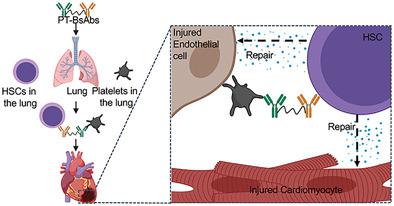Our official English website, www.x-mol.net, welcomes your
feedback! (Note: you will need to create a separate account there.)
Bispecific Antibody Inhalation Therapy for Redirecting Stem Cells from the Lungs to Repair Heart Injury
Advanced Science ( IF 14.3 ) Pub Date : 2020-11-19 , DOI: 10.1002/advs.202002127 Mengrui Liu 1, 2 , Halle Lutz 1 , Dashuai Zhu 1, 2 , Ke Huang 1 , Zhenhua Li 1, 2 , Phuong-Uyen C Dinh 1, 3 , Junqing Gao 4 , Yi Zhang 5 , Ke Cheng 1, 2
Advanced Science ( IF 14.3 ) Pub Date : 2020-11-19 , DOI: 10.1002/advs.202002127 Mengrui Liu 1, 2 , Halle Lutz 1 , Dashuai Zhu 1, 2 , Ke Huang 1 , Zhenhua Li 1, 2 , Phuong-Uyen C Dinh 1, 3 , Junqing Gao 4 , Yi Zhang 5 , Ke Cheng 1, 2
Affiliation

|
Stem cell therapy is a promising strategy for cardiac repair. However, clinical efficacy is hampered by poor cell engraftment and the elusive repair mechanisms of the transplanted stem cells. The lung is a reservoir of hematopoietic stem cells (HSCs) and a major biogenesis site for platelets. A strategy is sought to redirect lung resident stem cells to the injured heart for therapeutic repair after myocardial infarction (MI). To achieve this goal, CD34‐CD42b platelet‐targeting bispecific antibodies (PT‐BsAbs) are designed to simultaneously recognize HSCs (via CD34) and platelets (via CD42b). After inhalation delivery, PT‐BsAbs reach the lungs and conjoined HSCs and platelets. Due to the innate injury‐finding ability of platelets, PT‐BsAbs guide lung HSCs to the injured heart after MI. The redirected HSCs promote endogenous repair, leading to increased cardiac function. The repair mechanism involves angiomyogenesis and inflammation modulation. In addition, the inhalation route is superior to the intravenous route to deliver PT‐BsAbs in terms of the HSCs’ homing ability and therapeutic benefits. This work demonstrates that this novel inhalable antibody therapy, which harnesses platelets derived from the lungs, contributes to potent stem cell redirection and heart repair. This strategy is safe and effective in a mouse model of MI.
中文翻译:

双特异性抗体吸入疗法将干细胞从肺部重新定向以修复心脏损伤
干细胞疗法是一种有前途的心脏修复策略。然而,临床疗效受到细胞植入不良和移植干细胞难以捉摸的修复机制的阻碍。肺是造血干细胞(HSC)的储存库,也是血小板的主要生物发生位点。人们正在寻求一种策略,将肺驻留干细胞重新定向到受损的心脏,以在心肌梗塞(MI)后进行治疗性修复。为了实现这一目标,CD34-CD42b 血小板靶向双特异性抗体 (PT-BsAbs) 被设计为同时识别 HSC(通过 CD34)和血小板(通过 CD42b)。吸入递送后,PT-BsAb 到达肺部并与 HSC 和血小板结合。由于血小板固有的损伤发现能力,PT-BsAb 在 MI 后引导肺 HSC 到达受伤的心脏。重定向的 HSC 促进内源性修复,从而增强心脏功能。修复机制涉及血管肌生成和炎症调节。此外,就 HSC 的归巢能力和治疗效果而言,吸入途径输送 PT-BsAb 优于静脉途径。这项工作表明,这种新型可吸入抗体疗法利用来自肺部的血小板,有助于有效的干细胞重定向和心脏修复。该策略在 MI 小鼠模型中是安全有效的。
更新日期:2021-01-07
中文翻译:

双特异性抗体吸入疗法将干细胞从肺部重新定向以修复心脏损伤
干细胞疗法是一种有前途的心脏修复策略。然而,临床疗效受到细胞植入不良和移植干细胞难以捉摸的修复机制的阻碍。肺是造血干细胞(HSC)的储存库,也是血小板的主要生物发生位点。人们正在寻求一种策略,将肺驻留干细胞重新定向到受损的心脏,以在心肌梗塞(MI)后进行治疗性修复。为了实现这一目标,CD34-CD42b 血小板靶向双特异性抗体 (PT-BsAbs) 被设计为同时识别 HSC(通过 CD34)和血小板(通过 CD42b)。吸入递送后,PT-BsAb 到达肺部并与 HSC 和血小板结合。由于血小板固有的损伤发现能力,PT-BsAb 在 MI 后引导肺 HSC 到达受伤的心脏。重定向的 HSC 促进内源性修复,从而增强心脏功能。修复机制涉及血管肌生成和炎症调节。此外,就 HSC 的归巢能力和治疗效果而言,吸入途径输送 PT-BsAb 优于静脉途径。这项工作表明,这种新型可吸入抗体疗法利用来自肺部的血小板,有助于有效的干细胞重定向和心脏修复。该策略在 MI 小鼠模型中是安全有效的。











































 京公网安备 11010802027423号
京公网安备 11010802027423号